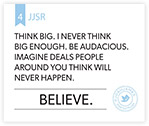We’ve been selling Domo for six months and we’ve hit a milestone that’s significant for any startup: We’ve signed 100 paying customers.
We’re still stealthy, meaning we haven’t shown our product to key influencers such as press, analysts or partners. We’ve only demoed to qualified prospects and only under NDA. And if you visit our website, you won’t see Domo screen shots or product videos. We’re keeping things under wraps by design.
Despite self-imposed handicaps, we’ve achieved in six short months something that took us two-and-a-half years to do at Omniture once we started selling to real businesses.
Fast forward to October 2010 when I founded Domo. It was a business I started to address the needs of users like myself — executives with tons of data about their business, but no useful way to get real value from it.
Our first year and a half was spent building product with our heads down and blinders on.
It was difficult, but one of the most important phases in company development that I’ve ever been through. When our earliest customers asked us to add or change something that wasn’t in our product roadmap, we ignored them. As customer-centric people, it was so unnatural to do that. It was also hard to be burning cash, knowing that we could be monetizing those customer requests.
But with Domo, I really didn’t want to create a better version of something already out there. If we were going to create something truly special, build something entirely new, we had to truly innovate and create something that inspired us while not being limited by industry boundaries, customer expectations or current feature lists. There would be plenty of time to listen to customers once Domo looked like the product we wanted.
We got to that point in August 2012. We had built something that would change how people thought about enterprise software. Our early customers had validated our vision, and the overwhelming interest in our product confirmed we had touched a nerve.
It was time to turn on our sales machine.
We let loose a team of phone reps focused on the mid market. Since we flipped that switch, it’s been go, go, go.
I’ve never seen sales cycles like the ones we’re experiencing at Domo. Deals are closing in days and weeks unlike traditional enterprise software deals, which typically take months, quarters and sometimes, even years.
We also are closing more deals over the phone at higher values and in shorter cycle times than I ever experienced with 6,000 customers at Omniture. In addition, our product is selling to executives across a variety of job functions and across a wide variety of industries – media and marketing, retail, telco, travel and leisure, financial services and professional services, to name a few.
Domo is probably still too young to put all our trust in this data, but we’re taking this overwhelming response as a very encouraging sign that we’re in the right place at the right time.
The World Has Changed
If you’ve ever had to sell enterprise software, our sales cycle sounds like a fairytale. But the world has changed. Business users are the buyers. They are a group with significant purchasing authority, and to date, they’ve been completely ignored by traditional enterprise software vendors.
And while the average deal size isn’t as big as a traditional sale to IT, the time-to-value for the customer is immediate. And that’s important. Additionally, the potential upside for software that touches every business user is huge.
Why Revenue Cures All Problems
There’s a difference between having 100 customers and 100 paying customers. Quite simply, the first scenario will contribute significantly to cash burn and the second will counter it.
But there’s more to it. I’ve always believed that revenue cures all problems. If you need to raise money, revenue makes investor conversations much more interesting and often makes them easier.
If you have product imperfections, once you have revenue, you’ll quickly figure out how to fix the bugs, otherwise you risk losing paying customers. The same goes for customer service and implementations. Problems? There’s nothing as powerful as a paying customer to ensure you are doing everything you can to deliver the best experience possible.
Revenue is a good salve for many of the challenges you and your startup are likely to face. Personally, I love revenue at this stage because it’s the best validation that we’re delivering value for which customers are willing to pay. It’s a five-star affirmation of our existence that gives our team the juice to keep charging forward.
What’s Next
I’m excited for what is ahead of us at Domo. We’re targeting the enterprise and have seen 30 percent of our revenue come from Fortune 2000 companies. We have killer engineering and sales teams that are taking things up a notch every day.
I’m also excited by the useful and positive feedback our customers are giving us along the way. It’s helping us optimize the value Domo brings to each and every customer.
If our early sales traction is any indication of what the future will bring, we’re in for a wild ride.
Josh









